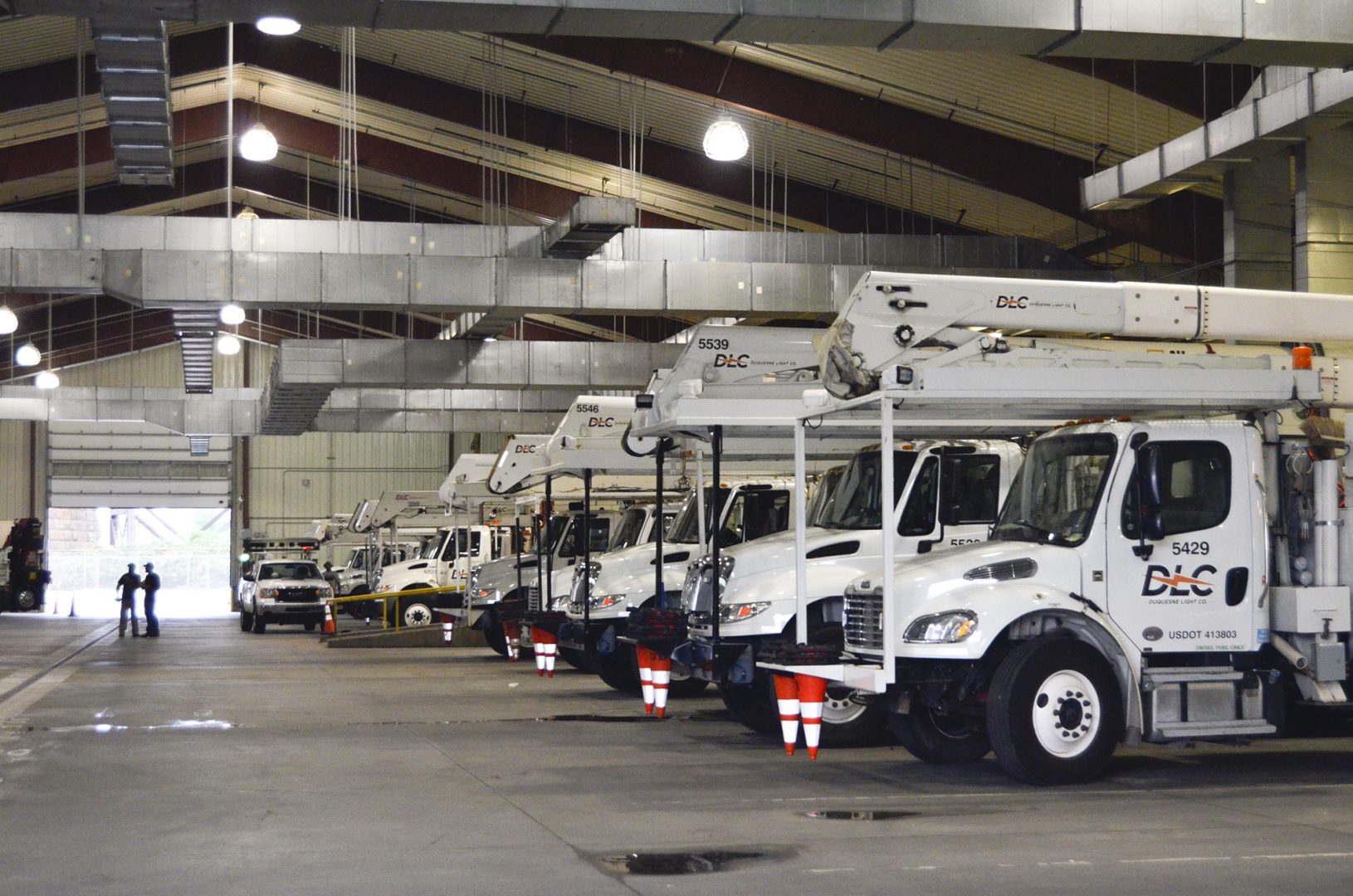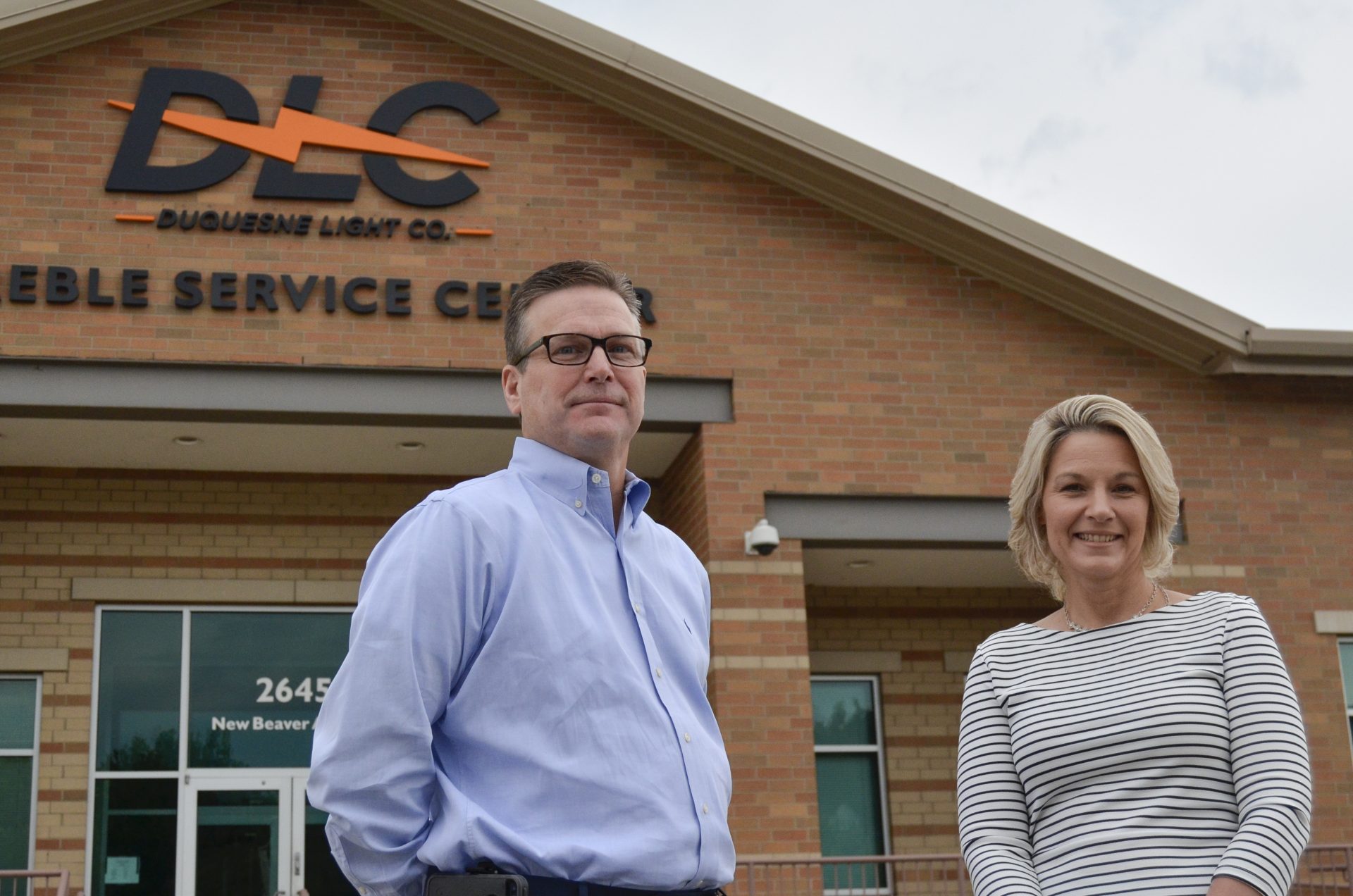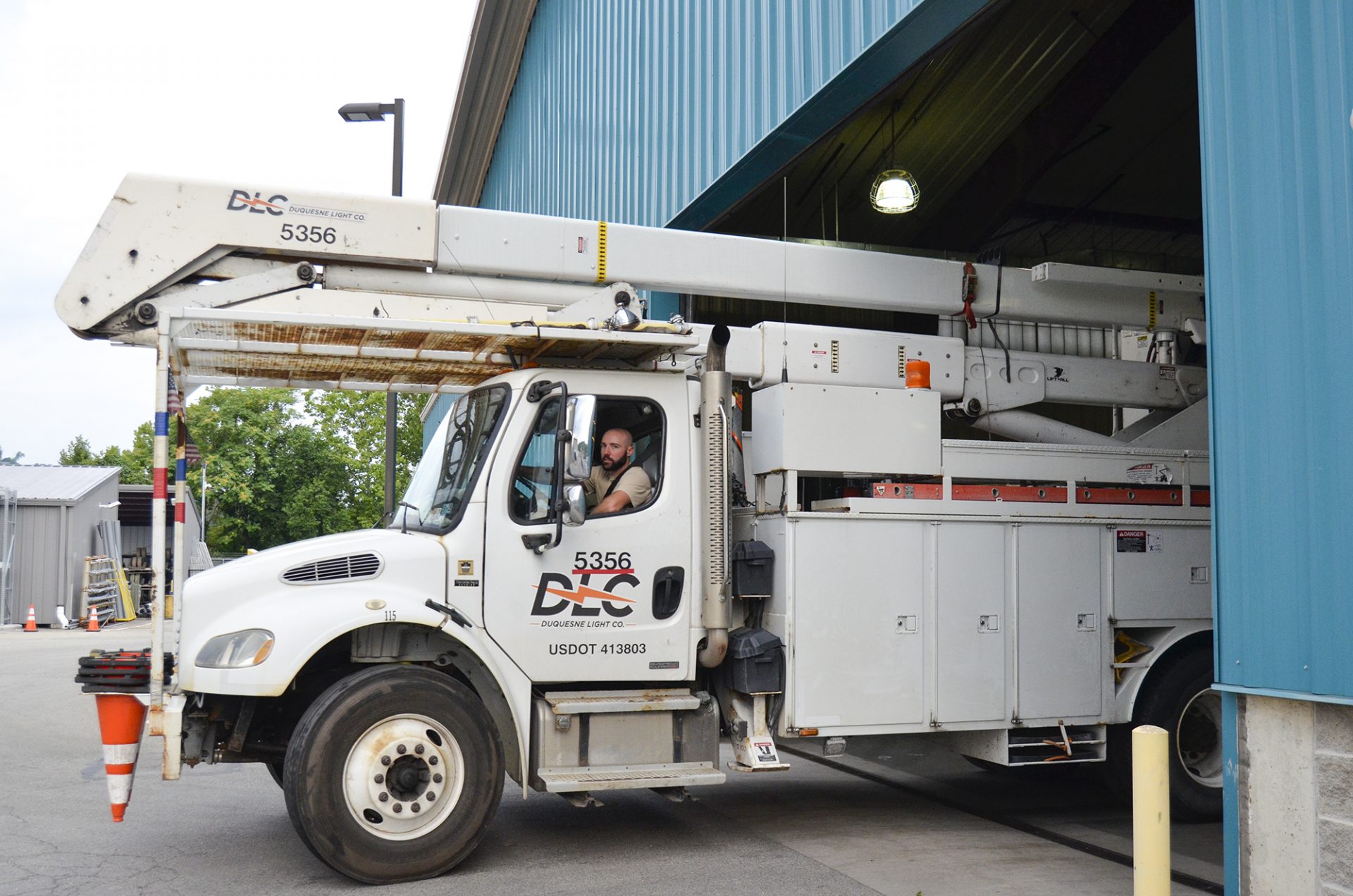
FILE PHOTO: Duquesne Light crews prepare their trucks for the day ahead installing new transformers, poles and auto-switches to reroute power around outages.
Amy Sisk / StateImpact Pennsylvania


FILE PHOTO: Duquesne Light crews prepare their trucks for the day ahead installing new transformers, poles and auto-switches to reroute power around outages.
Amy Sisk / StateImpact Pennsylvania

Amy Sisk / StateImpact Pennsylvania
FILE PHOTO: Duquesne Light crews prepare their trucks for the day ahead installing new transformers, poles and auto-switches to reroute power around outages.
When the power goes out, calls to local utility companies come flooding in from people like Joan Petrillo, manager of Martindale’s Natural Market in Springfield near Philadelphia.
She must decide whether to send out an employee for dry ice to keep meat and other cold goods from spoiling.
“You’re talking about a store with very little storage space,” she said. “So you have to buy it at the time it’s needed.”
It’s a balancing act. If the power’s expected to come back on in only a few minutes, the outage is no big deal. But too long without power or dry ice, and Petrillo is forced to dump food and re-order it when the lights come back on.
“You’re throwing out your livelihood, what puts you in business, but you have to be safe,” she said.
Businesses and Pennsylvania residents found themselves in the dark more than ever last year, with the Public Utility Commission reporting 50 significant outages in the state as storms pummeled the grid from Pittsburgh to Philadelphia. Those outages each resulted in more than 2,500 customers in the dark for longer than six hours.
Outages can vary widely year to year. In 2017, the state experienced more than double the year before, and 2018’s on track to be another above-average year. Through June, the PUC already reported 20.
In its latest reliability report, the PUC warns that if frequent severe weather continues, utilities will struggle to maintain adequate service.
Pennsylvania power companies can learn from recent extreme storms in places like Puerto Rico and Houston, said Katrina Kelly-Pitou, a research associate at the University of Pittsburgh’s Swanson School of Engineering and Center for Energy. Last year, Hurricane Harvey brought flooding and outages to Houston. And Hurricane Maria destroyed Puerto Rico’s power grid, resulting in months-long outages. Utilities that have taken steps to beef up their systems before a storm hits can bounce back more quickly.
“Invest now because it’s way cheaper than investing later,” Kelly-Pitou said.
Plus, climate change is expected to bring more intense weather.
“I now don’t know if we have time to say, ‘Let’s try to figure out what to do,’” she said. “I think you have to be doing something to be proactive in keeping your lights on.”
Storms plague Pennsylvania utilities
Of the 50 outages in Pennsylvania last year, 47 were caused by severe weather. Lightning, excessive rain, wind, ice and extreme temperatures all spell trouble for power companies.
Depending on where in the state they operate, they face different challenges.
Adams Electric Cooperative covers a five-county area around Gettysburg, where the emerald ash borer has found a home burrowing into the bark of trees.
“It’s hitting all of our region now,” CEO and general manager Steve Rasmussen said. “It’s really starting to be noticed in our service territory in south-central Pennsylvania the past couple years.”
The invasive beetle has become such a nuisance that this year, the co-op allocated money specifically to deal with damaged ash trees, which are more susceptible to falling on power lines when a storm hits. Adams Electric also recently opted to speed up its timeline for routine tree maintenance near its lines and other equipment.
“When you’re out in the countryside you tend to see more trees and more issues relating to trees,” Rasmussen said. “It’s definitely more of a challenge.”
To the west, heavy rains have led to an unusual number of landslides this past year that have damaged Duquesne Light equipment, said Warren Stough, director of field operations for the Pittsburgh-based utility.

Amy Sisk / StateImpact Pennsylvania
Warren Stough and Diane Holder of Duquesne Light are working on ways to improve the utility’s service and response during outages.
Severe weather led to six significant outages in 2017 for Duquesne Light. The utility had not experienced that many since 2010.
“It can put a lot of stress on your organization,” Stough said. “It wouldn’t be unusual for our employees to work 16 (hours) on, eight off until we have the power back on.”
What does it take to keep the power on?
The PUC monitors outage frequency and duration and sets targets for each utility. Overall, power companies’ performances dipped last year, though most still fall within their targets, spokesperson Nils Hagen-Frederiksen said. The PUC can make poorly performing utilities create improvement plans, and several have such plans right now.
Conversations about hardening utilities’ systems happen all the time, Hagen-Frederiksen said.
“We know weather is coming,” he said. “Regardless of the tempo of the weather, there will be at some point in the future be another hurricane. There will at some point be another torrential rainstorm.”
Hagen-Frederiksen says utilities need to ensure both reliability and resilience.
“Reliability is can you take a punch,” he said. “Resilience is how fast you get up off the canvas after you’ve been hit hard.”
Kelly-Pitou said utilities looking to improve their service as more storms hit are starting to use a number of innovative tools. Some, including Duquesne Light, are experimenting with microgrids, which create and distribute electricity for clusters of businesses or homes. They are also adopting “smart” technology like digital meters to monitor power usage and collect data about electricity demand in real-time.
On a recent clear morning, Duquesne Light crews rolled out from one of the utility’s service centers to get to work on a six-year, $250-million plan to upgrade the company’s systems beyond annual maintenance and improvements.

Amy Sisk / StateImpact Pennsylvania
A Duquesne Light bucket truck leaves the utility’s Preble Service Center.
“When I came in, I don’t think we had any customers out, so they’re all going out right now and are going to be working on what we refer to as ‘projects,’” Stough said.
That means installing new transformers and poles, as well as switches to automatically reroute power around an outage, which helps restore electricity to as many customers as possible while a crew drives out to fix the problem.
The company is also working toward faster response times with more sophisticated tools in its operations center, which is staffed 24/7 to monitor Duquesne Light’s power system.
For example, the utility is developing a detailed map of its grid, operations center director Diane Holder said. This will help company know exactly who’s lost power during a storm.
“An electric model will provide their electric address to us, their precise location on a circuit,” she said.
Along with the model will come a new digital system to react to outages, speeding up the process for staff who identify locations to dispatch crews.
For customers, it’ll provide a way to get updates on the situation.
“They could select the type of communication they’d like back from Duquesne Light, whether it’d be a text, an email, a phone call, and get regular updates throughout their outage as far as our progress,” Holder said.
That way, businesses such as grocery stores can make plans, like whether to run across town to stock up on dry ice.
StateImpact Pennsylvania is a collaboration among WITF, WHYY, and the Allegheny Front. Reporters Reid Frazier, Rachel McDevitt and Susan Phillips cover the commonwealth’s energy economy. Read their reports on this site, and hear them on public radio stations across Pennsylvania.
(listed by story count)
StateImpact Pennsylvania is a collaboration among WITF, WHYY, and the Allegheny Front. Reporters Reid Frazier, Rachel McDevitt and Susan Phillips cover the commonwealth’s energy economy. Read their reports on this site, and hear them on public radio stations across Pennsylvania.
Climate Solutions, a collaboration of news organizations, educational institutions and a theater company, uses engagement, education and storytelling to help central Pennsylvanians toward climate change literacy, resilience and adaptation. Our work will amplify how people are finding solutions to the challenges presented by a warming world.